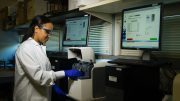Healthcare is highly demanding and complex. However, the industry is about to enter its next era, thanks to technology. Digital twins are transforming the industry from improving healthcare business operations to patient care. The healthcare digital twins market size is expected to grow at a CAGR of 26.31% between 2023-2033, from USD 489.7 25 million (£388,401 million) in 2022. Digital twins have already made their mark by helping transform sectors like manufacturing and engineering and are poised to play a vital role in healthcare by transforming clinical trial design, drug development, diagnosis, care coordination, and streamlining healthcare processes.
By creating virtual avatars of hospitals, medical devices, and even parts of the human body, researchers are trying to see how to use them to address real-world challenges of healthcare. For instance, neurological conditions are a major cause of disability and the reason behind 140,000 deaths annually in the UK. Millions continue living with such a condition. Now, technology is being used to create a virtual brain on which complex procedures and treatment methods can be modelled.
This is being done with digital twin technology, which creates virtual replicas of physical entities and simulates countless scenarios. This helps customize treatments for individual patients, predict the progress of their ailment, and test out possible interventions on the virtual replica rather than the actual patient, thus diminishing the risk factor.
In recent years, digital twins have helped providers find a way to maintain high-quality patient care while responding quickly.
Transforming the future of healthcare
Although still in the early stage of adoption, the use of digital twins in healthcare is advancing quickly, promising to transform how we diagnose and treat patients, and improve outcomes by realigning incentives. Increasingly, wearable sensors are being used to collect vital data in real time. These can be transferred and fed continuously to a remote server holding the user’s digital twin. Sensors can also help care providers remotely monitor vital signs, exercise routines and other useful data of patients who are less mobile and require constant supervision.
Digital twins can also be pivotal in providing performance prediction for a new product or process launch. Modern drug development necessitates the testing of a great number of possibilities in a highly controlled environment. These facilities are automated and prioritized using a digital twin of the lab. Researchers can modify drugs and test the attributes and applications of a medical device in a virtual environment before taking it to production, thus reducing costs of failure and improving the performance of the final product.
Here are just a few of the most compelling applications of digital twins in healthcare.
A digital twin of the human body can model organs, single cells, or an individual’s genetic makeup, physiological characteristics, and lifestyle habits to create personalized medicine and treatment plans. Doctors can use customized simulations to track the reactions of each patient to different treatments, which increases the accuracy of the overall treatment plan. This capability can transform the management of chronic diseases.
The treatment approach can be modified by observing a virtual avatar of a potentially problematic organ. Multiple research teams across Europe and the US are trying to build a virtual heart so that treatment can be personalised and tailored to individual patient needs. At the same time, the technology helps track the progression of diseases over time and understand their response to new drugs, treatments, or surgical interventions. Digital twins can also be used to optimize drug dosage for people with chronic pain, using data relating to age, lifestyle, etc. to predict the effects of pain medication.
Medical devices such as automated insulin pumps, pacemakers, and even novel brain treatments need constant monitoring and optimization, which is another area that digital twins can help with. Here a patient-specific digital twin is generated from lab tests, ultrasound, imaging devices, genetic tests and other data sources. A regulatory framework is being defined by the FDA to allow companies to formalize this offering.
Digital twins can monitor usage, performance, and upcoming repair of medical devices in real-time, which is crucial in asset-intensive facilities where these devices need to be available always.
While digital twin technology is demonstrating success in increasing the efficiency of healthcare, the adoption of data analytics and machine learning, telemedicine and remote patient monitoring further drive its adoption. The use of automation and robotics in other sectors is also expected to amplify demand for digital twin technology.
Overcoming hurdles to adoption
These use cases show how digital twin technology can make healthcare more effective, and demonstrate its potential to save countless lives while reducing the burden on healthcare professionals.
However, the rising cost of healthcare means only institutions with sound financial capabilities can realistically afford digital twin technology. The most advanced treatments may not be available to those who need them the most. Also, poor-quality data can affect the reliability of digital twin models used in diagnosis and treatment, possibly doing more harm than good.
An industry-wide collaborative effort is essential for the successful deployment of digital twins that will fast-track us into the next era of healthcare. Strategic alliances will drive innovative product launches and value-based care. In addition, healthcare providers must look out for new technologies and processes that will drive better patient outcomes without cutting corners on data quality, security, and privacy aspects.
By Venky Ananth, EVP and Global Head of Healthcare, Infosys




